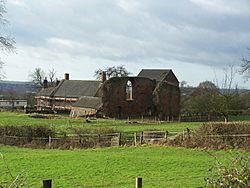Beauvale Priory facts for kids

The Structural Remains of Beauvale Priory in 2007
|
|
| Monastery information | |
|---|---|
| Full name | The Priory Church of the Holy Trinity, Beauvale |
| Other names | Beauvale Charterhouse |
| Order | Carthusian |
| Established | 1343 |
| Disestablished | 1539 |
| Dedicated to | Holy Trinity |
| People | |
| Founder(s) | Nicholas de Cantiloup, Lord of Ilkeston |
| Site | |
| Location | Beauvale, Nottinghamshire, England |
| Coordinates | 53°02′11″N 1°16′02″W / 53.036424°N 1.267206°W |
| Public access | yes |
Beauvale Priory, also called Beauvale Charterhouse, was a special kind of monastery in Beauvale, Nottinghamshire. It was home to Carthusian monks. Today, it's a protected ancient site, meaning it's an important historical place.
Contents
History of Beauvale Priory
Beauvale Priory was started in 1343 by Nicholas de Cantelupe. He was a powerful lord from Ilkeston. The priory was built to honor the Holy Trinity.
When it was first built, Beauvale Priory was meant to house a prior (the leader) and twelve monks. It was the third of nine Carthusian monasteries built in England. The Carthusian order was known for its monks living very simple and quiet lives.
Other Carthusian houses were in places like Witham Friary and Hinton in Somerset. There were also monasteries in London Charterhouse, Coventry, Kingston upon Hull, Mount Grace, Epworth, and Shene.
In 1534, official records showed the priory had a good income. It also controlled some local churches.
Beauvale's Role in Mysticism
Some historians believe Beauvale Priory played a part in English spirituality during the late Middle Ages. One idea is that the author of a famous book called The Cloud of Unknowing might have been a Carthusian monk from Beauvale. Another idea suggests that Beauvale might have been a key place for studying the writings of the English mystic Richard Rolle.
Dissolution and the Monks' Fate
During the 1530s, King Henry VIII wanted to be the head of the church in England, not the Pope. Many monasteries were closed down in what was called the Dissolution of the Monasteries.
The Carthusian monks, including those at Beauvale, refused to accept King Henry VIII as the supreme head of the Church. They believed the Pope was the true head.
Prior Robert Lawrence's Stand
In 1535, Robert Lawrence, who was the Prior of Beauvale, went to London. He hoped to convince Thomas Cromwell, a powerful advisor to the King, to save his priory. However, Cromwell did not meet with him.
Prior Lawrence and two other Carthusian Priors were arrested and put in the Tower of London. They were accused of being traitors. One of these was John Houghton, who had been the Prior of Beauvale before Lawrence.
On April 20, Prior Lawrence was questioned. He bravely stated that he could not accept the King as the head of the Church. He believed the Bishop of Rome (the Pope) was the head, as taught by early Christian leaders.
The Trial and Execution
On April 28, the three Carthusian Priors and a monk from another monastery were put on trial. They were charged with "verbal treason" for saying the King was not the supreme head of the Church of England.
At first, the jury did not want to find them guilty. They felt the monks had not acted with bad intentions. But Cromwell pressured the jury very strongly until they changed their minds and found them guilty.
Prior Lawrence became one of a group known as the Carthusian Martyrs. He and the others were sentenced to death. They were taken to Tyburn on May 4 and executed. Prior Lawrence wore his monk's robes during his execution.
In 1970, Pope Paul VI recognized Robert Lawrence as a saint. He is one of the Forty Martyrs of England and Wales.
The Priory's Final Days
Beauvale Priory's annual income was just under £200. This was the limit for smaller monasteries to be closed. The monks paid a large fine to delay the closure. This agreement was made in January 1538.
However, Beauvale Priory was finally closed on July 18, 1539. The Prior, Thomas Woodcock, and seven other monks signed the surrender document. Prior Woodcock received a yearly payment after the priory closed.
In 1541, the priory and most of its lands were given to Sir William Huse. Another part of the priory's land went to Sir John Porte in 1540.
List of Priors
Here are some of the known leaders (Priors) of Beauvale Priory:
- William, around 1404
- Richard de Burton, around 1422, 1426
- Thomas Metheley, around 1468
- John Swift, around 1478
- Thomas Wydder, around 1482
- Nicholas Wartre, around 1486
- John Houghton, 1531
- Robert Lawrence, executed 1535
- Thomas Woodcock, 1537 – surrendered 1539
What Remains Today
Some old tiles and pieces of stained glass from Beauvale Priory can now be seen in St. Mary's Church in Greasley. Two old handwritten books that were once in the priory's library still exist today.
There are still many parts of the priory buildings left. The entire site is a protected ancient site. This is because many features have survived, and Carthusian houses were rare in England. Beauvale was one of only nine such houses. The monks were well-respected for keeping their strict way of life until the priory closed.
The site was first protected on April 10, 1915. The individual buildings were given special protection in 1952. The remains of the Priory Church are listed as Grade II* (very important). The Gatehouse and parts of the wall are listed as Grade II. The Abbey Farmhouse, built in the 1500s, used stones from the priory.
Beauvale in Literature
The ruins of Beauvale Priory were used as the setting for a short story by the famous writer D.H. Lawrence. The story is called "A Fragment of Stained Glass."


